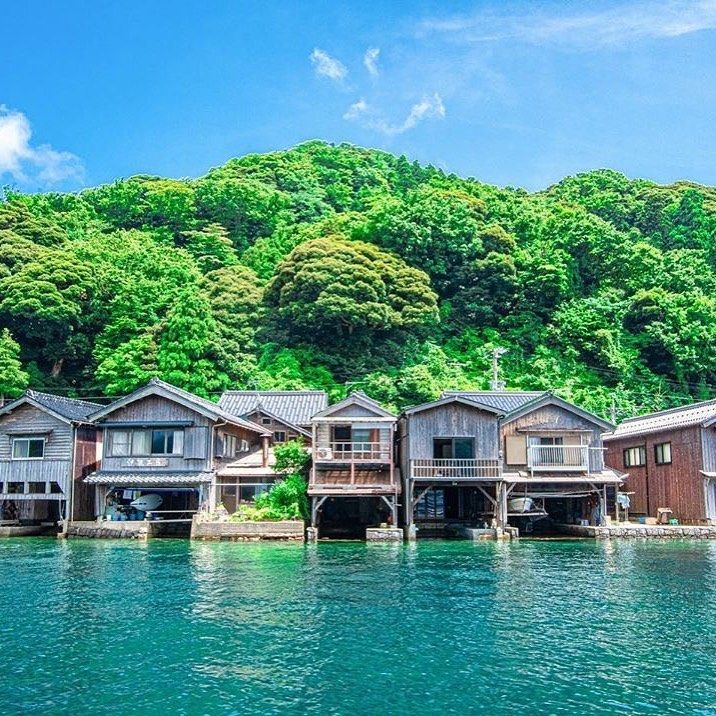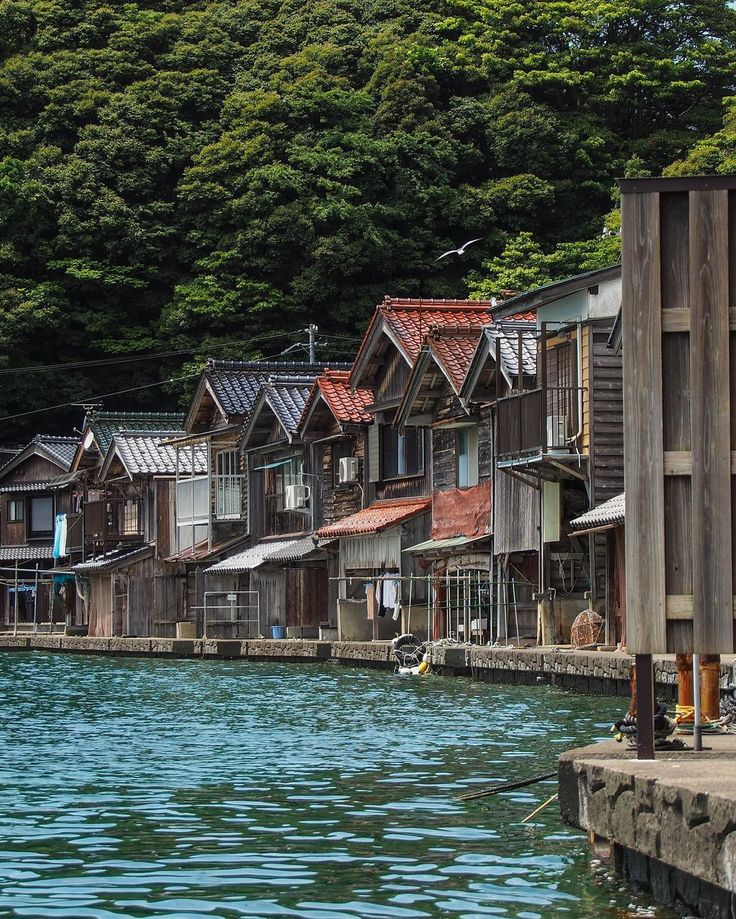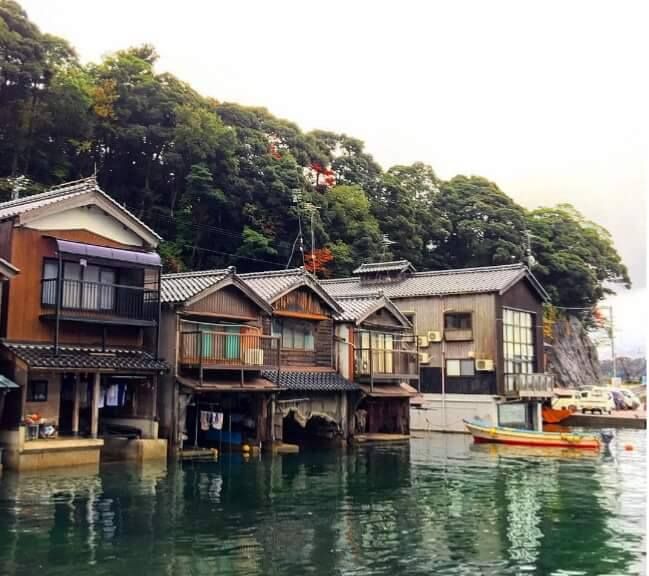The train journey from Kyoto city had been a gradual unwinding, a slow transition from the urban clamor to the coastal serenity of the Tango Peninsula. From Amanohashidate, famed for its “bridge to heaven” sandbar, Kenji, a maritime historian with a penchant for unique coastal cultures, had taken a local bus that hugged the rugged, indented coastline. His destination was Ine, a fishing village unlike any other in Japan, renowned for its funaya – distinctive “boat houses” built directly over the water, their ground floors serving as garages for fishing boats. He’d seen photographs, of course, but he yearned to experience the living reality of this extraordinary amphibious architecture and the way of life it represented.
As the bus rounded a final headland, Ine Bay unfurled before him, a tranquil, almost enclosed body of water cradled by steep, verdant hills. And there they were: a ribbon of over two hundred funaya lining the water’s edge, their wooden facades weathered by sea salt and sun, their tiled roofs reflecting the glint of the bay. They weren’t set back from the water; they embraced it, their lower levels open to the gentle lapping of the waves, their upper stories forming the living quarters. It was a breathtaking sight, a seamless fusion of land and sea, home and livelihood.
Kenji alighted from the bus, the air immediately thick with the briny scent of the ocean, mingled with the faintest hint of diesel from a returning fishing boat and the subtle aroma of drying seaweed. The main village road ran parallel to the bay, separated from the funaya by only a narrow strip of land, sometimes just wide enough for the road itself. On the landward side of the road were the omoya, the main residential houses, often connected to their waterside funaya by short walkways or directly across the street.

His guesthouse, Funaya no Yado Kura, was itself a converted funaya, offering guests the unique experience of sleeping directly above the water. Stepping into the ground floor, he was met with the cool, damp smell of the sea and the sight of a small fishing boat bobbing gently in its watery garage, its engine covered, nets neatly stowed. A simple wooden staircase led to the upper floor, which had been beautifully renovated into a comfortable tatami room with a wide window offering an uninterrupted view of Ine Bay. From here, Kenji could watch the rhythmic rise and fall of the tide, the comings and goings of other fishing boats, and the ever-changing play of light on the water.
His host, Mr. Hamada, a weathered fisherman with eyes that crinkled at the corners from years of squinting at the sun-dappled sea, greeted him with a warm, gruff welcome. “Welcome to Ine, Professor,” he said, using Kenji’s professional title with a touch of old-fashioned respect. “Not many places like this left in the world.”
Indeed, Ine felt like a world unto itself. The funaya were not just a picturesque architectural style; they were a deeply practical solution to the challenges and opportunities of living in a narrow coastal strip with limited flat land. By building directly over the water, the fishermen could easily launch and retrieve their boats, protected from the elements, and keep their fishing gear readily accessible. The ground floor boat garages also provided a cool, shaded space for mending nets, repairing engines, and processing the day’s catch.
Over the next few days, Kenji immersed himself in the life of Ine. He quickly learned that the best way to truly appreciate the funaya was from the water. He took a sightseeing boat tour that circumnavigated the bay, offering a unique perspective of the houses rising directly from the sea, their reflections shimmering on the surface. The boatman, a local fisherman, pointed out different features: the varying designs of the boat garages, some with traditional wooden slatted doors, others more open; the davits and hoists used for lifting boats or heavy catches; and the small, personal touches that distinguished each home. He explained that many of the funaya were over a century old, built from resilient local timber, their designs refined over generations to withstand the marine environment.
Kenji also rented a sea kayak, allowing him to explore the nooks and crannies of the bay at his own pace. Paddling quietly past the funaya, he could hear the sounds of life emanating from within: the clatter of kitchenware, the murmur of conversations, the occasional burst of laughter. He saw fishermen mending nets in their boat garages, their movements practiced and efficient. He observed how the tides dictated the rhythm of activity, with boats heading out in the early morning darkness and returning laden with their catch as the day progressed.
He learned that Ine’s primary catch was buri (yellowtail), particularly prized during the winter months, along with squid, mackerel, and various types of shellfish. The bay itself, sheltered and rich in nutrients, acted as a natural fish farm for some species. The connection between the villagers and the sea was absolute, an unbreakable bond that had shaped their culture, their architecture, and their very identity for centuries.
Mr. Hamada, when he wasn’t out on his boat, proved to be a rich source of information and anecdotes. He explained that the funaya were traditionally built without nails in their main structure, relying on intricate joinery techniques that allowed the wood to flex and breathe with the changing humidity and temperature. He spoke of the challenges of maintaining these wooden structures in a harsh marine environment, the constant battle against salt corrosion and wood rot, and the specialized skills required for their repair and preservation.
“This isn’t just a house, Professor,” Mr. Hamada said one evening, gesturing from the veranda of Kenji’s room towards the darkening bay. “It’s part of us. My grandfather built this funaya. My father fished from it. Now I do. The sea is in our blood, and these houses are our connection to it.”

Kenji spent hours walking the narrow road that snaked through the village, observing the interplay between the omoya (main houses) on the landward side and the funaya on the seaward side. Many families owned both, using the omoya for more formal living and sleeping quarters, and the funaya as a combination of workspace, storage, and sometimes simpler, more rustic accommodation. He noticed the small, carefully tended vegetable patches tucked into tiny pockets of land beside the omoya, evidence of the villagers’ resourcefulness.
He visited the Ine Town Furusato Exchange Center, a small museum that provided further historical context, showcasing traditional fishing gear, models of funaya construction, and photographs of Ine from bygone eras. He was struck by the continuity, the way the fundamental design of the funaya and the core fishing practices had remained remarkably consistent over time, adapting subtly to new technologies but retaining their essential character.
The local cuisine, naturally, revolved around seafood. Kenji savored incredibly fresh sashimi, grilled fish seasoned simply with salt, and hearty fisherman’s stews, often enjoyed in small, family-run eateries that overlooked the bay. He learned about heshiko, a traditional preserved fish (usually mackerel or sardine) packed in rice bran and salt, a staple that had sustained fishing communities through lean times.
One afternoon, Kenji witnessed the return of a fleet of small fishing boats. The scene was one of quiet, practiced efficiency. Boats were expertly maneuvered into their funaya garages. Catches were unloaded. Nets were rinsed and hung to dry. There was a sense of shared purpose, of a community working in tandem with the rhythms of the sea. He saw families helping each other, a testament to the strong social fabric of the village.
He also became aware of the delicate balance Ine was striving to maintain. Tourism was increasingly important for the local economy, providing a vital income stream and an incentive for preserving the unique heritage of the funaya. Many funaya had been converted into guesthouses or cafes, offering visitors an unparalleled experience. Yet, there was a clear desire among the villagers to ensure that tourism didn’t overwhelm the authentic fishing culture that was the village’s lifeblood. It was still very much a working fishing village, not just a picturesque backdrop.
Kenji, the historian, found himself fascinated by this dynamic. Ine was a living example of how a community could adapt to changing economic realities while fiercely protecting its core identity. The funaya were not just relics of the past; they were active participants in the present, evolving to meet new needs while retaining their essential form and function.
His sketchbook filled with detailed drawings of funaya cross-sections, studies of boat hull designs, and portraits of the fishermen he met, their faces weathered by sun and sea, their eyes holding a deep, quiet wisdom. He tried to capture the unique quality of light in Ine – the way it reflected off the water and danced on the wooden walls of the funaya, the soft glow of lanterns in the evening, the dramatic skies over the bay during sunrise and sunset.

He learned that the design of the funaya was not uniform. Some were older, more rustic, their timbers dark and gnarled. Others were newer, or more recently renovated, with brighter wood and perhaps more modern amenities. But all shared the fundamental characteristic of the ground-floor boat garage, the defining feature that made Ine so unique. This architectural typology was a direct and ingenious response to the specific geography of Ine Bay and the primary livelihood of its inhabitants.
As his stay drew to a close, Kenji felt a profound respect for the people of Ine. Their connection to the sea was not just economic; it was spiritual, cultural, deeply ingrained in their way of life. The funaya were the ultimate expression of this connection, a testament to human ingenuity and a harmonious relationship with the marine environment.
On his last evening, he sat on the small balcony of his funaya guesthouse, watching the fishing boats silhouetted against the moonlit bay. The gentle lapping of water beneath him was a soothing lullaby. He thought about the generations of fishermen who had lived and worked in these very houses, their lives dictated by the tides, the seasons, and the bounty of the sea. Ine was more than just a unique fishing village; it was a living repository of maritime heritage, a place where the past and present flowed together as seamlessly as the waters of the bay.
Mr. Hamada joined him, offering a small cup of local sake. “The sea gives, and the sea takes,” Mr. Hamada said, his gaze fixed on the horizon. “But Ine endures. These funaya are our anchors.”
Kenji knew he would carry the image of Ine’s boat houses with him always – their sturdy forms rising from the water, their open garages ready to welcome the returning boats, their upper windows like eyes looking out onto the bay. It was a place that had not just met his expectations, but had surpassed them, offering a profound insight into a resilient and beautiful way of life, forever tethered to the sea. The unique fishing village, with its homes that literally embraced the ocean, had captured a piece of his historian’s heart.

